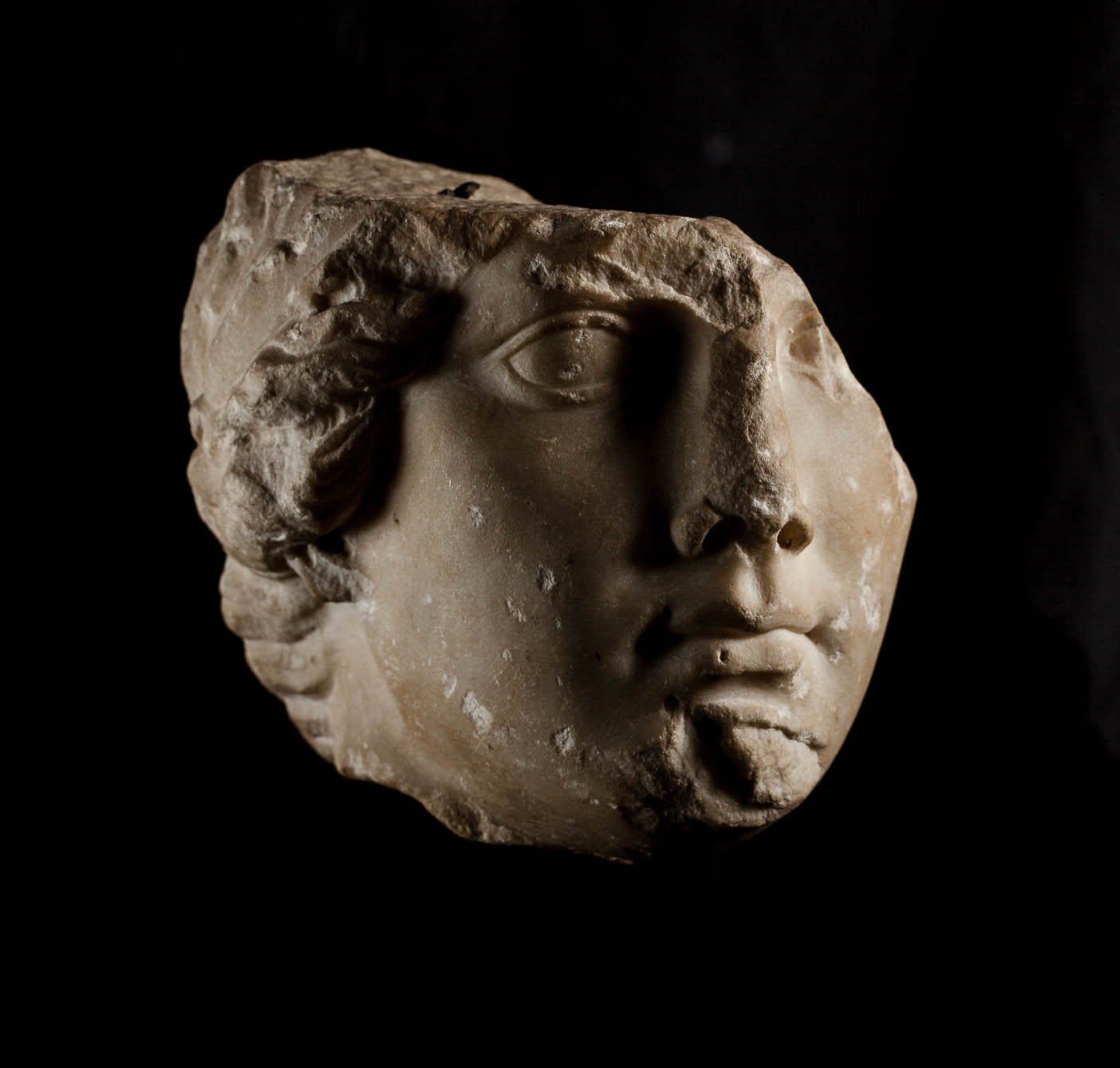Head of female divinity
The life-sized head is of a young woman in an attitude of serene composure. Though impaired by severe fractures, the face displays considerable formal and aesthetic qualities that make the work very pleasing. The full, oblong oval of the face presents large, round, wide-open eyes set on an axis with a slight external inclination. The surviving portion suggests that the supraorbital ridge cast no shadow over the eyes. The smooth, abraded eyeballs are outlined by flat borders. The upper eyelid cuts the lower at the outer corner and joins up with the supraorbital ridge through a slight swelling. The disproportion in the measurements of the neck, which was carved for greater height on the right side, suggests a slight twist of the head to the left. The slightly asymmetrical positioning of the eyes, with the left just a little higher than the right, derives from the natural inclination of the head to the right. Though harmoniously blended, all of the facial features are pronounced. The regular nasal ridge ends in a broad base with slightly dilated nostrils above a fleshy, mobile philtrum. The closed mouth is wide with curved, voluptuous lips and “swallow-tail” dimples at the corners. Areas of shadow emphasize these depressions, which disappear in a gradual progression of planes so that the elastic vibrations perceptible in the nasolabial folds and the mouth dissolve into the smooth, dry skin of the cheeks. The profile view of the head enhances the delicate fleshiness of the modelling, whose tendency to conceal the bony structure beneath is particularly noticeable in the yielding plumpness below the chin. The soft consistency of the volumes sweetens the expression of the face, attenuating the impression of coldness and rigidity given by fixity of its gaze. The largest portion of the hair can be seen in the right profile and shows that the hairstyle developed in two directions: in wavy ridges at the back, presumably on either side of a now lost centre parting, and in thick bands on the temples covering the tips of the ears. The hair then continues onto the nape, as can also be seen on the left side of the head, where it forms a large plait or pony tail, only the beginning of which is carved. This well-known hairstyle, attested as from the late Classical age above all on Attic tombstones, includes a long plait hanging down the back and is always associated with virgins or young women. The surviving hair, with its fluid, unstable outline, is streaked on the surface and made up of thick S-shaped locks gathered in an unruly mop, which creates an effect of immediacy and spontaneity. The hair is also characterized by summary treatment and a rough, rugged surface contrasting with the smoothness of the face, which is precisely worked with a rasp and abrasives. Despite chipping in some places on the right, the lower profile of the head is too regular to be the result of accidental breakage and is thus to be regarded as a deliberate cut, certainly made in ancient times. The head was therefore fashioned separately and attached to the neck by means of a pin, the original circular socket for which still survives. Further confirmation that the head belonged to a composite sculpture made up of matching elements is provided by the cutting of the top section, again in ancient times. This complex system served for the attachment of a fairly large element. One hypothesis would be the completion of the head with a single L-shaped insert including both the neck and the remaining portion of the skull with the hair, the continuation of the plait down the back being probably carved together with the body. The use of a similar technique is found in the fine Delos portrait (inv. no. 6780) of the late 2nd century BC of a young man with a determined expression. This portrait was obtained from the juxtaposition of two blocks of Parian marble, one for the face and the other for the back of the head, the neck and the socket for attachment to the body. In the hair on the right side of the head it is just possible to make out a sort of rough-hewn flat strip below the level of the locks in front, which could be mistaken at first sight for a band or diadem. This served for the attachment of an attribute, which may have been of metal despite of the absence of any traces of oxidation. It could have been a diadem, crown or basileion headdress. The presence of a deep hole in the back of the right lobe can instead be connected with earrings despite the unusual type of attachment (the holes for earrings usually pierce the lobe). The sculpture’s poor state of preservation prevents precise determination of the technique employed. In the absence of further evidence, it is in fact impossible to establish whether the statue was produced by means of the pseudo-acrolithic technique, which involves the assemblage of different types of marble, or of “piecing”, which is much the same but uses blocks of the same type of marble. In any case, both of these techniques are broadly attested in both Hellenistic and Imperial Roman statuary. The limited iconographic elements available suggest that the head, complete with a decorative attribute and plait, probably represented a young goddess like Artemis and thus forms part of the variegated panorama of the iconic representations of divinities of the late Hellenistic age in Rome. In stylistic terms, the work bears a marked Classical imprint, recognizable in the symmetrical disposition of the features, elegantly rounded shape of the eyes and closed lips and makes it possible to suggest a preliminary dating in the second half of the 1st century BC.







